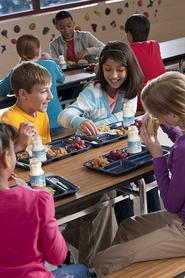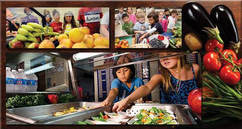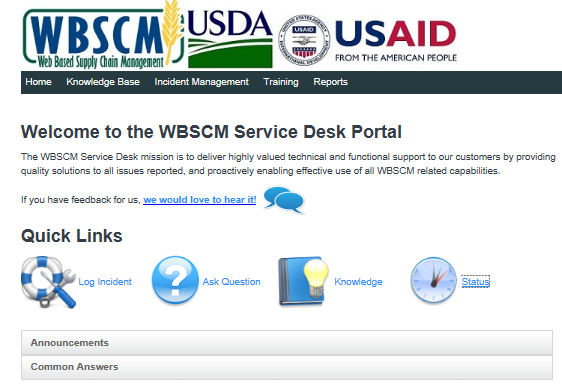|
MORE THAN 70 YEARS OF CHANGE!
 Seventy years have passed since the signing of the National School Lunch Act of 1946. But USDA Foods, formerly referred to as commodities, have been available to schools since the 1930s. Agriculture support programs were designed to help the American farmers and the poor suffering from the economic upheaval of the Great Depression by making federal funds available to purchase domestic commodities. The growing support for a lunch program in schools after WWII brought the National School Lunch Act in 1946 “to safeguard the health and well-being of the Nation's children and to encourage the domestic consumption of nutritious agricultural commodities."
Other milestones in the evolution of the National School Lunch Program (NSLP) include:
1966: President Johnson signed the Child Nutrition Act, to expand the program and add a nutrition dimension to what started as an agriculture support program. This provision added a pilot breakfast program, SAE funds, and equipment funds to further support the efforts of the NSLP.
1987: The Commodity Distribution Reform Act of 1987 mandated program improvements such as school district input into foods orders, state performance standards, and providing technical assistance on commodity use and nutritional data.
1994: The School Meal Initiative for Healthy Children revised the nutrition standards for school meals and caused an extensive review of commodity specifications to improve their nutritional profile.
1995: The Department of Defense Fresh Fruit and Vegetable pilot program started with 8 States purchasing $3.2 million of produce.
2001: A federally managed National Processing Program was established to allow States and school districts to convert bulk commodities into further processed end products.
2002: USDA introduced ECOS, the Electronic Commodity Ordering System, to support a shift to demand-driven ordering for commodities.
2008: USDA rebranded the “commodity” program as the “USDA Foods” Program with more of a school district customer service focus. Nutrition quality of products was also further improved with the introduction of whole grains, low sodium options, and lower fat and sugar choices.
See the "History of the NSLP" article below for further details on these important events and the improvements to USDA Foods over the years!
|
 Announcing the Nutrition and Technical Assistance Branch's New PartnerWeb Site!
In
an effort to better communicate with food industry, software developers,
Regional offices, State agencies, and other FNS stakeholders and partners, the Food and Nutrition Service (FNS) has developed a new nutrition and technical assistance share point site on USDA’s PartnerWeb site.
PartnerWeb is a collection of secured collaboration Web sites, intended for information exchange with organizations and individuals who conduct business directly with FNS. The nutrition and technical assistance site will be used to share new and updated nutrition technical assistance resources, memos, trainings, webinars, and other helpful information and resources. New postings on the site will be announced via email. Users
must have a PartnerWeb account created by FNS in order to gain access to the
site. New users can request an account by simply sending an email to cnpntab@fns.usda.gov with the following
information: contact name, valid email address, business address, and business
phone number.
After having some time to view and experience the site, please feel free to share any ideas on other useful items you would like to be included on the site at cnpntab@fns.usda.gov.
|
 USDA Recipe Standardization Project
On April 8, FNS announced the availability, on USDA’s What’s Cooking website, of 50 newly modernized and standardized recipes for use in schools and childcare centers. These recipes were developed to assist NSLP, School Breakfast Program, and Child and Adult Care Food Program operators in meeting the new meal pattern requirements by providing appealing, kid-approved meals that incorporate whole grains and vegetables (dark green, red/orange, and beans/peas vegetable subgroups). In total, 200 recipes were developed under the USDA Recipe Standardization Project, and they will be published on USDA’s What’s Cooking website, in groups of fifty, as they become available, with an anticipated completion date of April 2017. Print versions will be available at a later date.
|
"USDA Foods Processing from Soup to Nuts" Webinar Series
The recordings of our recent webinar series are now available on the Food Distribution playlist on the USDA Food and Nutrition Service YouTube channel. Thank you to everyone who joined our webinars this spring, and we invite you to review the information, share the videos with your colleagues, or catch up on any sessions you missed!
|
|
 |

Connecting
the Dots: How USDA's and DoD's Collaboration Provides Fresh Produce for NSLP
During World War II, many
young men were rejected from the United States military draft due to medical conditions caused by
childhood malnutrition. This became a matter of national security and caused alarm at the Department of Defense (DoD). The rates of
malnutrition among the draftees, as well as the general health of the nation’s
children, led to the signing of the National School Lunch Act (NSLA) in 1946 by
President Harry Truman.
Almost
50 years later, in 1995, USDA began working collaboratively with DoD to leverage their
extensive procurement system. The Defense Logistics Agency (DLA) procures
thousands of items including fresh produce to support
the nation’s military bases and troops around the world. Through the DoD Fresh Fruit and Vegetable
Program, schools can choose to use their USDA Foods entitlement dollars to buy
fresh produce. Schools have access to many different types of produce, in multiple forms, including
pre-cut options, and in a variety of pack sizes. DoD vendors are also encouraged to offer
schools locally grown produce.
Schools
in 47 states, the District of Columbia, Puerto Rico, the Virgin Islands, and
Guam participate. This successful collaborative
effort between USDA and DoD has increased the variety of produce items offered
to the nation’s military bases and troops and has steadily increased the quantity
of fresh fruits and vegetables delivered to schools. Children who learn to enjoy eating fruits and
vegetables at a young age develop a healthy eating pattern to continue as an adult. The DoD Fresh Program helps to improve the overall
health of our nation.
For concerns regarding produce received through the DoD Fresh Fruit
and Vegetable Program, State Distributing Agencies should contact their designated DLA Service Representative
for customer service. If an issue is not resolved, please contact the USDA
Foods Complaints Team. The Complaint Team is
available Monday-Friday, 6:00 a.m. – 5:00 p.m. Eastern Time. Email USDAFoodsComplaints@fns.usda.gov or call the USDA
Foods Complaint Hotline at 800-446-6991.
|
DoD Fresh Produce for Summer Food Service Program
In April, functionality to support the Summer Food Service Program (SFSP) was added to the Fresh Fruits and Vegetables Order Receipt System (FFAVORS). To date, eight states have set up their delivery locations and budget in FFAVORS to use entitlement dollars to purchase fresh produce for their SFSP sites this summer. To learn more about using FFAVORS to support SFSP, State Agencies should make inquiries with their FNS regional office contact.
Changes to WBSCM Service Desk
As of May 24, 2016, the email address for the Web-Based Supply Chain Management (WBSCM) Service Desk has changed. All WBSCM users will receive periodic notifications to remind them of the new contact information throughout the next few months. The current contact information is as follows:
Phone: 877-WBSCM-4U (877-927-2648)
Email: WBSCM.servicedesk@CACI.com
Along with this change, WBSCM users now have improved ability to report incidents and track status via an online self-service portal. Users can also search and view historical incidents. A searchable Knowledge Database with answers to common questions in in development.
The WBSCM Service Desk Portal may be accessed at any time (24/7). First time visitors will enter their email address for both the User ID and Password (all lowercase) and will be prompted to create a new password for future access.

Publication of Donated Foods Final Rule – 7 CFR Part 250
FNS published a Final rule in the Federal Register, Requirements for the Distribution and Control of Donated Foods & The Emergency Food Assistance Program: Implementation of the Agricultural Act of 2014, on April 19, 2016. This rule revises and clarifies FNS regulations to ensure that USDA Foods are distributed, stored, and managed in the safest, most efficient, and cost-effective manner, at State and recipient agency levels. The rule also reduces administrative and reporting requirements for State distributing agencies, revises or clarifies regulatory provisions relating to accountability for USDA Foods, and rewrites much of the USDA Foods regulations at 7 CFR part 250 in a more user-friendly, “plain language,” format. Lastly, the rule revises and clarifies specific requirements in The Emergency Food Assistance Program to conform more closely to related requirements in 7 CFR part 250 and current law. This rule impacts State and local agencies administering Food
Distribution Programs, as well as school food authorities and industry partners.
View the final rule here

As we celebrate the 70th anniversary of the National School
Lunch Program, how have school cafeterias
evolved into ones that look more like food courts today?
In the early 1900s, few schools offered lunch programs. Most city children went home for a home-cooked meal, while many rural
schools let children go home or eat a home-packed lunch if they lived too far
away. But as more women began working outside their homes, several organizations
became involved with ensuring the children were fed hot meals. In rural areas, teachers began to devise plans on how to make
soups or other hot dishes brought in by the students, using the stove that heated the classroom as the means to heat the foods. The
depression years of the 1930s deepened the concern over malnourished children, and States began passing laws authorizing local schools boards to operate lunchrooms.
The passing of the National School Lunch Act
in June of 1946 reassured school boards the program would continue, especially Section 5 which
provided funding to be distributed to the States to assist school districts in
purchasing equipment for the program. The dining areas were filled with large heavy
tables with individual chairs. The meals
were served on glass plates, and milk was served in a glass. The idea of the assembly line manner of feeding children
actually came about in the 1880s. Brothers William and Samuel Childs opened several lunchrooms in which
patrons would push their trays along a counter, choosing the items they
wanted. This method was adopted by
school districts as it was practical for serving large groups of children.
While the mid-90s brought the fast-food industry into many
schools, by the early 2000s many
districts began overhauling the school lunch line again, with a food court feel and colorful stations offering healthier choices and many fresh fruits and vegetables. Now many districts are trying new ways to keep high school
children on campus, such as food trucks serving USDA Foods as part of a reimbursable meal.
No matter how the
cafeteria has changed, the goal has remained the same: Feed the
children!
1960s photo of students eating lunch
At the time of the 1966 Child Nutrition Act, programs provided a variety of commodity items, such as cheddar cheese in 40 # blocks, nonfat dry milk in 50 kilo bags, butter, honey, rice, and flour.
In 1987, the year the Commodity Distribution Reform Act mandated a variety of program improvements, USDA Secretary Lyng reflected on the program's evolution: “Beginning with the passage of the National School Lunch Act in 1946, food distribution took on the additional purpose of promoting healthful diets for children and needy Americans. The need to provide service has resulted in a far greater array of commodities than was previously available. Years ago, the types of food donated were fewer, and they were more likely to arrive in bulky cuts and unwieldy containers."
The 1990s ushered in additional nutrition improvements. In 1992 the ground beef fat content, previously 24%, was reduced to 15%. The School Meal Initiative for Healthy Children, passed in 1994, revised the nutrition standards for school meals and caused an extensive commodity specifications review to improve the nutritional profile.
At the turn of the century, the commodity program was ‘reinvented’ to better serve school children, low-income households, and the agricultural community. New features included the National Processing Program, established in 2001, and a State pilot of an electronic commodity ordering system (ECOS) driven by school districts’ requests for foods that fit their menus.
More significant changes for USDA Foods came in 2008, as the “commodity” program was rebranded as the “USDA Foods” Program. At this time, USDA also made great strides in improving the nutrition quality of USDA Foods by introducing whole grain options, changing all vegetable and bean products to a low-sodium specification, and lowering fat, sodium, and added sugar in products across all food categories.
The basic premise of the program remains rooted in U.S. agriculture, and drought, disease, and market issues will always impact USDA Foods. Nevertheless the program is ever changing and continues to improve. The Foods Available List (FAL) has steadily increased, from about 50 offerings in the 1970s, to 81 in 1987, more than 140 in 1994, and more than 200 for School Year (SY) 2017. Thank you, school districts and States, for supporting the USDA Foods program and supporting change to continuously improve the program!
Read more about the history of the National School Lunch Program (NSLP)
USDA staff will be participating in these upcoming meetings in 2016. We look forward to the opportunity to meet you and hope to see you there!
July 31 - August 3: School Nutrition Association of Pennsylvania 2016 Annual Conference, Hershey, Pennsylvania. Come visit the USDA Foods booth in the exhibit hall on Tuesday, August 2!
October 31 - November 3: 2016 USDA/State Agency Meeting, Arlington, Virginia. USDA Foods presentations include a pre-conference session, USDA Foods – Behind the Scenes, and three break-out sessions: Manage USDA & Commercial Food Chains Like a Pro, USDA Foods: What Child Nutrition Staff Need to Know, and USDA Resources: Available to Assist When Handling
Disasters.
 Here's how to sign up for these updates via GovDelivery:
1. Go to the Food Distribution website.
2. Click on the red envelope on the row of social media icons on the top right of the page.
3. Enter your email address and click "Submit."
4. Check the boxes to select your topics of interest. For these e-letters, scroll down to the Food Distribution category and click the plus sign to the left of the check box to expand the list and view all the sub-categories. Check these sub-categories to receive the corresponding e-letters:
|
*USDA Foods --> receive all "USDA Foods from Farm to Plate" general + program-specific e-letters
*Commodity Supplemental Food Program (CSFP) --> receive "Household Highlights" e-letter
*The Emergency Food Assistance Program (TEFAP) --> receive "Household Highlights" e-letter
*Food Distribution Program on Indian Reservations (FDPIR) --> receive "FDPIR Connection" e-letter
*Schools/Child Nutrition Commodity Programs --> receive "Spotlight on Schools" e-letter
5. Update your subscription preferences any time by following the above steps or clicking on the Subscriber Preferences Page link at the bottom of any of the e-letter email messages you receive from GovDelivery. Questions? Contact us at USDAFoods@fns.usda.gov
|